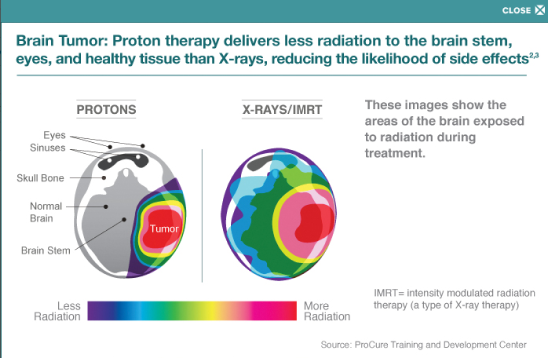A five-year-old British boy with a major brain tumor and his parents became the object of an international manhunt, an Interpol arrest of the parents, an extradition proceeding, and a medical/ethical controversy over a controversial cancer therapy that took place over the Labor Day weekend.
Last Thursday, Brett and Naghmeh King removed their son, Ashya, from Southampton General Hospital where he had been a patient, and fled to Spain, where they own a property, and where they hope to be able to raise funding to get Ashya proton beam therapy, which is only available in the U.K. at one facility to treat a rare ocular cancer, melanoma of the eye, although patients with other forms of cancer can apply for U.K. National Health Service (NHS) funding to receive the therapy in other countries, including Switzerland and the US.
Proton beam therapy is a type of radiation therapy that uses beams of protons — fragments of atoms — instead of the high energy (and potentially damaging to surrounding tissue) X-rays used in conventional radiotherapy. Proton beams can be more precisely targeted on a tumor, and unlike X-rays, proton beam radiation falls off very sharply over a proverbial “cliff’,” as it were, reaching its target with intensity but then dropping off sharply and doesn’t travel very much further. This makes proton beams suitable for treating vulnerable areas of the body where it’s important to minimize the risk of unwanted side-effects to surrounding tissue. The beams stop penetrating once they hit the designated target, rather than carrying on through the body, releasing substantial doses of energy to healthy tissue and organs on the way to the tumor and continues to deliver radiation as it leaves the body, analogous to exit wounds left by a bullet, in contrast with the fewer side-effects and less collateral damage caused by proton beam therapy. Unfortunately, proton beam treatment is very expensive, with the NHS reportedly estimating the average cost of to be £100,000 ($165,061.00) USD per patient.
A trial in which up to 1,500 cancer patients will be offered the treatment at hospitals in London and Manchester is scheduled to begin in early 2018, but that’s cold comfort for young Ashya and his family.
Meanwhile, British medical authorities and police took a dim view of the parents removing their son from hospital care and launched the continent-wide manhunt for the Kings. The parents were arrested in Malaga, Spain, on Saturday, separated from Ashya, and taken into custody pending outcome of an extradition hearing. They have not been charged with breaking any Spanish laws. Ashya has been admitted to a hospital in Malaga.
In a YouTube video posted by Brett King, he called the police chase “ridiculous” and explained that he and his wife wanted Ashya to receive proton beam radiotherapy because they didn’t want him “pelted with radiation” with conventional X-ray radiotherapy. He said he and his wife had “pleaded” with Southampton General Hospital for Ashya to receive proton beam therapy, but were told it would have “no benefit whatsoever.” The hospital told the BBC that they had offered the Kings access to a second opinion, as well as assistance with organizing treatment abroad.
However, The Independent reported Tuesday that U.K. authorities’ heavy-handed treatment of this case has incited a popular and social media backlash, with as of Tuesday morning, some more than 130,000 people having signed an online petition appealing to U.K. Prime Minister David Cameron to personally request that Mr. and Mrs. King be immediately released from custody in Spain and reunited with Ashya. Mr. Cameron’s coalition partner Deputy Prime Minister Nick Clegg is quoted saying it was inappropriate to “throw the full force of the law” at the Kings and to separate them from Ashya, commenting on BBC Breakfast that “as far as I can make out, this is a family in a state of real anguish who have taken this exceptional step of moving their sick child to another country because they think that’s what is best for their child.”
[adrotate group=”1″]
So what is proton beam therapy?
According to Cancer Research U.K., instead of using X-rays, proton beam therapy aims proton beams at the cancer. Protons are part of the center of the atom — the atomic nucleus — and carry a positive electrical charge. They release energy as they travel and slow down. They then cause a peak of energy at their target point — “the Bragg peak” in medical terminology. Broadly speaking, the protons release their energy when they stop rather than when they are traveling through tissue. As a result, most of the radiation goes directly to the cancer, reducing damage to the surrounding normal tissue. Ion beam therapy has the same principle but uses carbon ions rather than protons. Carbon ions peak more sharply than protons.
Like conventional radiotherapy, proton beam radiotherapy increases the likelihood of killing cancer cells by directing higher dose radiation directly at the tumor. Because of its more precise targeting, the treatment spares healthy tissue, particularly tissues and organs behind the tumor. Because less healthy tissue is included in the radiotherapy field, there could be fewer long term side effects.
Cancer Research U.K. reports that early results from trials using proton beam radiotherapy are promising, and that some reports show the treatment works well, with fewer side effects than standard radiotherapy. However, they caution that there is no evidence that people going abroad for this treatment do any better than those having conventional radiotherapy in the UK.
 In blog entry, Dr Kat Arney, a former research-scientist who now works as a Science Communicator for Cancer Research U.K., cautions that while the U.K. government has pledged £250 million to build two new NHS proton beam centers, before getting too excited about this new treatment, it’s important to know that it’s thought only around one percent of UK cancer patients could be suitable for proton therapy, and that there’s a lack of hard conventional evidence to prove that it’s more effective and kinder to the body than conventional radiotherapy.
In blog entry, Dr Kat Arney, a former research-scientist who now works as a Science Communicator for Cancer Research U.K., cautions that while the U.K. government has pledged £250 million to build two new NHS proton beam centers, before getting too excited about this new treatment, it’s important to know that it’s thought only around one percent of UK cancer patients could be suitable for proton therapy, and that there’s a lack of hard conventional evidence to prove that it’s more effective and kinder to the body than conventional radiotherapy.
Dr. Arney notes that over the past 50 years, advances in technology radiotherapy have enabled doctors to shape exposures increasingly more precise in order to match the shape and size of a patient’s tumor, and that some of the latest machines can even track how tumors move as a person breathes, to make sure they’re hitting as little healthy tissue as possible while zapping the cancer. However, she points out that no matter how advanced techniques get, a fundamental problem with X-ray radiotherapy is that once the beams have entered a person’s body, they keep going and there will inevitably be some potential damage, leading to short or long-term side effects, and these unwanted side-effects can be particularly harmful for children (and especially those being treated for brain tumors), since their bodies are still developing and are more susceptible to the effects of radiation. Children treated with radiotherapy are also more at risk of developing a second cancer later in life, caused by their early exposure to radiation, and that one way to avoid these problems is to zap tumors with a beam of protons, rather than X-rays.
The one U.K. facility that does offer proton beam therapy, the Clatterbridge Cancer Centre at Wirral, issued a statement Monday acknowledging that it’s natural for people to be wondering why the hospital can’t use it to treat Ashya King and other children with brain tumors.
The reason they say is that there are actually two different types of proton beam therapy: high-energy and low-energy, and the Clatterbridge Cancer Center’s beam is low-energy — specifically designed to treat eye cancers — so the beam only travels very short distances of less than three centimeters.
That means, unfortunately, that the beam doesn’t travel far enough to treat a brain cancer, a procedure that would require a high-energy proton beam, and that currently there is nowhere in the UK that has a high-energy proton beam.
The statement says cure rates are the same with both proton beam therapy and other radiotherapy using x-rays, but the benefit of proton beam therapy is said to be a potential reduction in late side-effects.
In the U.S., Proton beam therapy is offered at the Procure Proton Therapy Center in Oklahoma City and the University of Florida Proton Therapy Institute.
Procure Proton says patients weighing options for cancer treatment generally consider two main factors in their treatment decisions: side-effects of the treatment itself and the likelihood for a successful outcome. They note that with proton radiation therapy, side effects are generally fewer in number and less in severity than other radiation therapy side effects, resulting in a better quality of life during and after cancer treatment, and that since side effects from proton therapy tend to be less severe, physicians may be able to treat tumors with higher doses of proton radiation. This means that, while patients enjoy an option with fewer cancer treatment side effects, they can also look forward to favorable results. Put simply, delivering the optimal dose of radiation can be easier with proton therapy.
According to Procure Proton, proton therapy is more appropriate for certain types of cancer than others, and is primarily used to treat base-of-skull tumors, brain tumors, breast cancer, gastrointestinal (go) cancers, head and neck tumors, lung cancer, melanoma of the eye, pediatric cancers, prostate cancer, and tumors near the spine. Benefits cited include fewer short- and long-term side effects, reduced likelihood of secondary tumors caused by treatment, improved quality of life during and after treatment, and proton beam therapy can be used to treat recurrent tumors, even in patients who have already received radiation. THey note that proton therapy is often the preferred option for treating solid tumors in children because protons can be controlled precisely so there is less radiation of normal tissues, helping prevent serious complications and lessening the chance of secondary tumors. For more information, a video can be viewed at: http://www.procure.com/xml/moa-video.xml
The University of Florida Proton Therapy Institute notes that since the side effects from proton therapy tend to be less severe, physicians may be able to treat tumors with higher doses of proton radiation, meaning that, while patients enjoy an option with fewer cancer treatment side effects, they can also look forward to favorable results. Put simply, they say delivering the optimal dose of radiation can be easier with proton therapy, and that as part of a non-profit academic medical research facility, the faculty and staff of the University of Florida Proton Therapy Institute are dedicated to furthering the study of cancer treatment and minimizing cancer treatment side effects – while increasing its efficacy and excellent outcomes.
Sources:
Cancer Research U.K.
Clatterbridge Cancer Centre
Procure Proton Therapy Center
University of Florida Proton Therapy Institut
BBC News
The Independent
YouTube
Image Credits:
Epigenetics.eu
Procure Proton Therapy Center


